Meadowsweet, Filipendula ulmaria - this simple plant has several names. Culture among gardeners and landscapers is valued because the flowering is beautiful and long. Meadowsweet blooms in red, white, cream, purple and violet, depending on the variety. Meadowsweet grass is a medicinal plant, people even say that meadowsweet can cure 40 diseases.
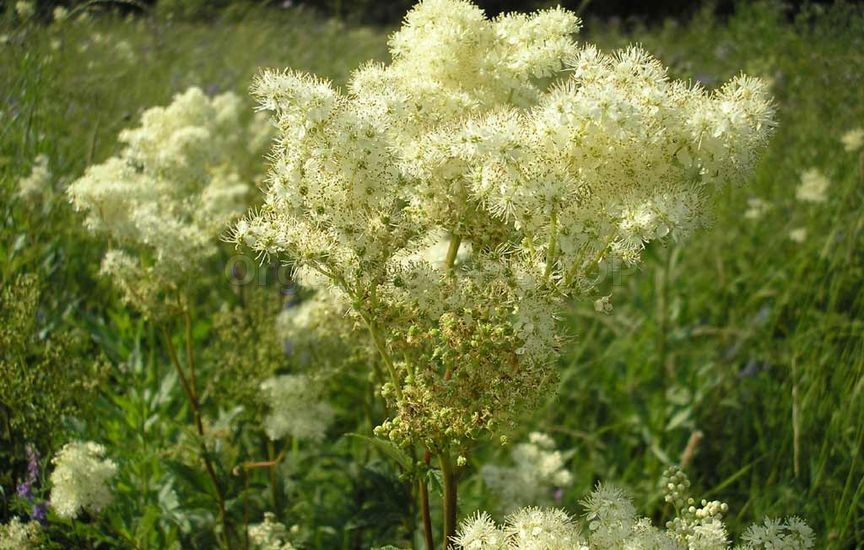
Meadowsweet is a perennial, up to a meter tall, straight stem, beautifully flowering plant. For many years, the meadowsweet was not considered as a separate plant species, it was equated with the Spirea genus, but more recently, breeders have singled out meadowsweet as an independent genus that includes several species.
Short description: Meadowsweet flowers are white, beige, pale yellow, no more than 1 cm in diameter, formed into separate panicles or bushes, reaching a diameter of about 15 cm.
The leaves of the plant resemble fern leaves, they are pinnate and wide. Due to the large leaves of meadowsweet, a lot of moisture leaves the plant in the heat. Because of this feature, some species of meadowsweet dry up in mid-July-August, but this is a temporary phenomenon. After the heat subsides, the plant recovers.
The meadowsweet has a poorly developed root system; in a year, the roots increase by only 3 cm, sometimes even less. This feature does not affect the flowering and development of the plant.
Flowering period - with the onset of summer, if the weather is favorable. Flowering continues for 6 weeks. During flowering, meadowsweet has a very pleasant aroma, reminiscent of almonds with honey notes.
Where does meadowsweet grow? In the wild, meadowsweet grows more near water bodies, where there is a lot of moisture. You can find a plant in wetlands, as well as in meadows, in the forest at the foot and on the slopes of low mountains. In the wild, meadowsweet grows strongly and grows rapidly, so you can see a whole impenetrable meadowsweet plantation.
Interesting: fragrant tea can be made from meadowsweet inflorescences. The drink will turn out with a pleasant honey aroma and almond taste.
Planting meadowsweet in open ground
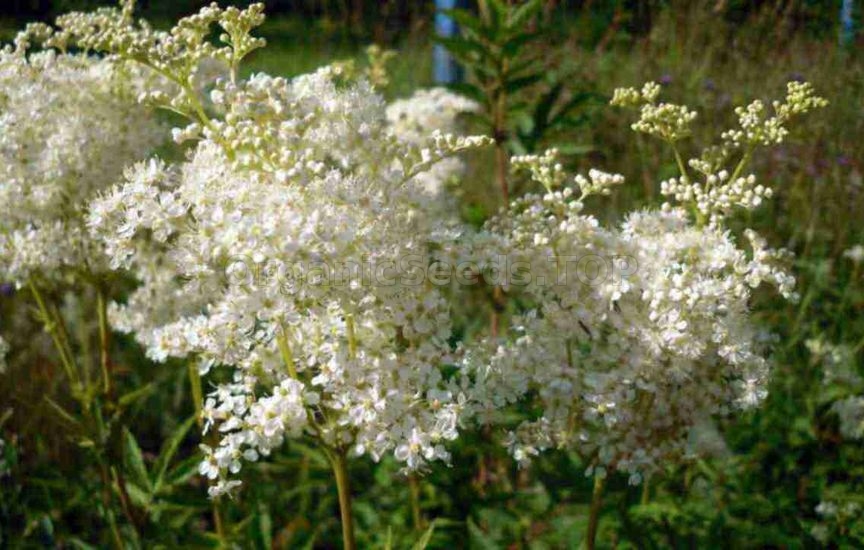
Location selection
For growing meadowsweet in open ground, it is best to choose a site with moist soil, but at the same time, water should not stagnate on it. In the event that groundwater lies very close to the surface of the site, then it is recommended to make a high bed for the shrub and do not forget about a thick layer of drainage.
A suitable area for such a plant may be slightly shaded. Please note that it cannot be grown in the shade. It is best for him to choose a sunny open place or an area that will only be slightly shaded by plants growing nearby.
Priming
Meadowsweet is not particularly demanding on the composition of the soil. However, it grows best in neutral nutrient soil. If the soil in the area is acidic, then before planting a shrub, it is recommended to add wood ash or lime to it. Also, during the digging of the site, it is desirable to add compost or humus to the soil.
The plant also prefers well-drained soil. Therefore, if the soil is heavy, then sand should be added to it.
Reproduction methods
Meadowsweet can be propagated in several ways: dividing the bush, seeds and part of the rhizome.
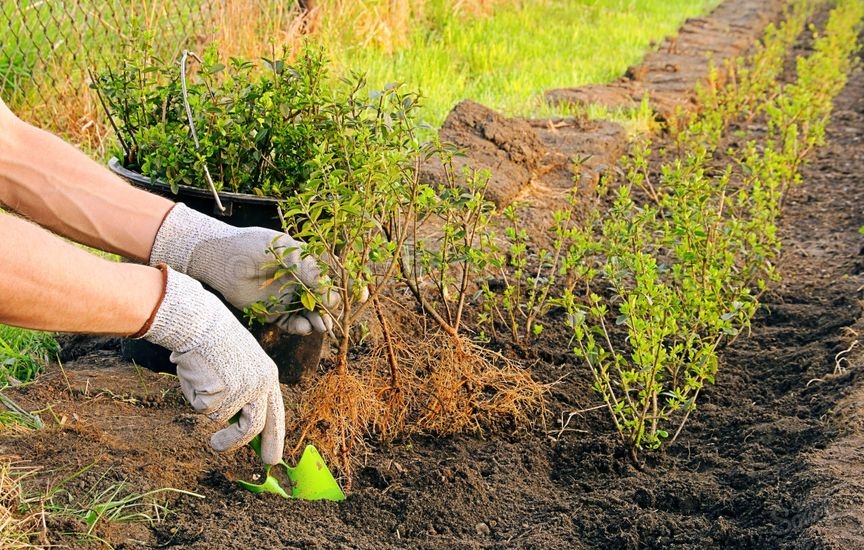
Growing from seed
Meadowsweet seeds need natural stratification and hardening. That is why it is recommended to sow them before winter. To begin with, from the site selected for sowing, you need to remove all weeds, after which it is moistened. The seeds of this plant are highly photosensitive. In this regard, they are recommended to be sown in a shady place (not in the shade). Later, grown seedlings can be planted in a permanent place.
It is necessary to deepen the seed material into the soil by no more than 50 mm. Otherwise, the sprouts will not be able to break through a thick layer of soil. The distance between seeds should be from 0.3 to 0.4 m. Thanks to such a rare planting, young plants will be able to grow and develop within the normal range without interfering with each other.
The first seedlings should appear already in the second half of April or in the first - May. They are very slow growing. As a rule, by the end of the season, up to five leaf plates are formed on each bush. In this form, they hibernate under the snow. For the first time, the bushes will bloom only in the second or third year of growth. In the event that the plant is in unsuitable conditions for growth, then it can bloom much later.
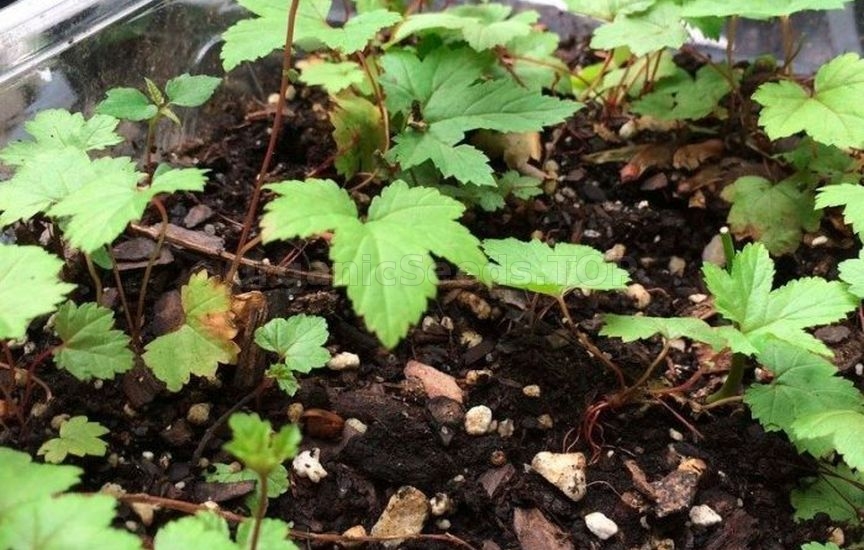 If desired, sowing seeds can be carried out in the spring. Before sowing, seed material needs to be prepared. To do this, it is immersed for some time in a solution of a growth stimulator, for example, Novosil or Zircon. Crops need timely and proper moisture, as well as shading, which can be artificial or natural. But even if you do everything right, be prepared for the fact that the seeds will not germinate during spring sowing.
The seeds of the meadowsweet remain viable, as a rule, for 6 years. However, the germination period can be significantly reduced, this is greatly influenced by the place of collection or cultivation.
If you still decide to sow the meadowsweet in the spring, then keep in mind that the bushes that appear will grow extremely slowly, and their first flowering will come no earlier than the third or fourth year of growth. Therefore, despite the fact that you sow the meadowsweet in the spring, it will bloom much later than the bushes that have grown after the winter sowing.
If desired, sowing seeds can be carried out in the spring. Before sowing, seed material needs to be prepared. To do this, it is immersed for some time in a solution of a growth stimulator, for example, Novosil or Zircon. Crops need timely and proper moisture, as well as shading, which can be artificial or natural. But even if you do everything right, be prepared for the fact that the seeds will not germinate during spring sowing.
The seeds of the meadowsweet remain viable, as a rule, for 6 years. However, the germination period can be significantly reduced, this is greatly influenced by the place of collection or cultivation.
If you still decide to sow the meadowsweet in the spring, then keep in mind that the bushes that appear will grow extremely slowly, and their first flowering will come no earlier than the third or fourth year of growth. Therefore, despite the fact that you sow the meadowsweet in the spring, it will bloom much later than the bushes that have grown after the winter sowing.
The division of the bush
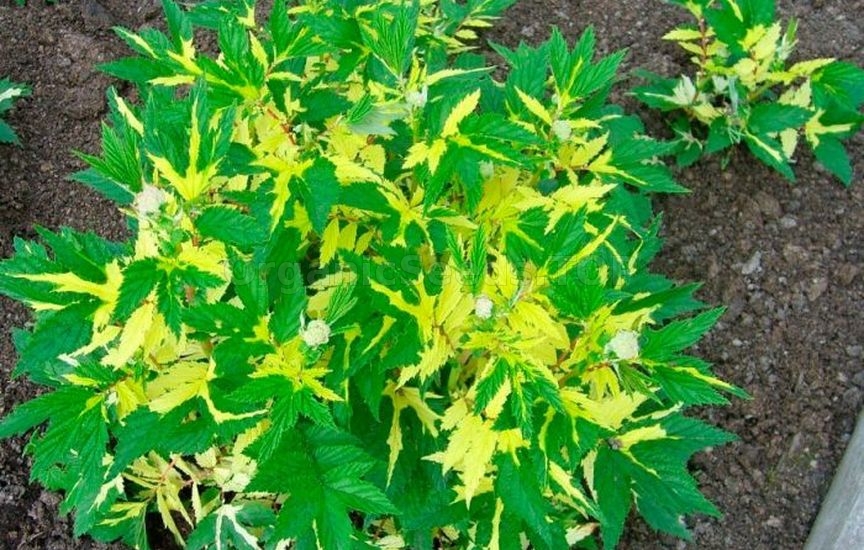 Reproduction of the meadowsweet by dividing the bush is more popular with gardeners than by seeds. You can divide the bush into parts in the autumn, when it fades, or at the very beginning of spring - from March to April. When choosing the time for dividing the bush, it should be remembered that after a spring transplant, meadowsweet will bloom later than after an autumn one.
Dig the bush out of the ground and divide its rhizome into several parts. Delenki are recommended to be planted in the soil immediately after dividing. If you divided the plant in the fall, and you are going to plant the delenki only in the spring, in order to save them, it is recommended to bury parts of the bush in moistened sawdust or earth.
When planting delenki between them, a distance of at least half a meter should be observed. They should be buried in the soil no more than 50 mm. In the hole, the roots should be horizontal, and the pointed tops of the kidneys should be directed upwards. Remember that there should be no weeds and plant residues near young bushes. Also, do not forget about good drainage and constant soil moisture. Delenki take root quite well, while they bloom much earlier than bushes grown from seeds.
Reproduction of the meadowsweet by dividing the bush is more popular with gardeners than by seeds. You can divide the bush into parts in the autumn, when it fades, or at the very beginning of spring - from March to April. When choosing the time for dividing the bush, it should be remembered that after a spring transplant, meadowsweet will bloom later than after an autumn one.
Dig the bush out of the ground and divide its rhizome into several parts. Delenki are recommended to be planted in the soil immediately after dividing. If you divided the plant in the fall, and you are going to plant the delenki only in the spring, in order to save them, it is recommended to bury parts of the bush in moistened sawdust or earth.
When planting delenki between them, a distance of at least half a meter should be observed. They should be buried in the soil no more than 50 mm. In the hole, the roots should be horizontal, and the pointed tops of the kidneys should be directed upwards. Remember that there should be no weeds and plant residues near young bushes. Also, do not forget about good drainage and constant soil moisture. Delenki take root quite well, while they bloom much earlier than bushes grown from seeds.
Meadowsweet Care
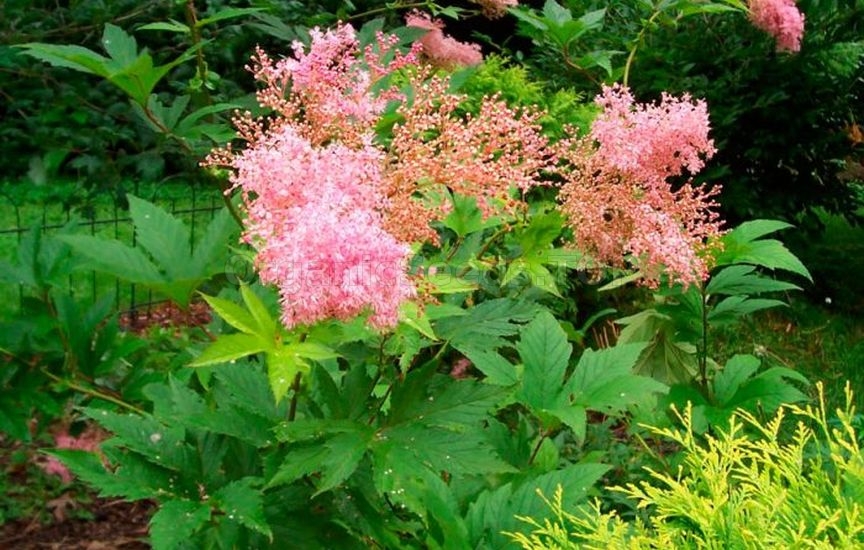
Watering
The meadowsweet, grown in open ground, needs timely and proper watering. Water the bushes abundantly, avoiding stagnation of fluid in the root system, as this can provoke the development of a fungal disease. On average, it is watered 1 time in 7 days.
top dressing
When growing meadowsweet in nutrient soil, you can do without top dressing. However, for better growth and lush flowering, experts advise feeding it 1 or 2 times during the season with organic matter or mineral fertilizer (for example, potassium sulfate, superphosphate). Remember that a large amount of nitrogen cannot be applied to the soil, as this can cause the bushes to bloom much later.
pruning
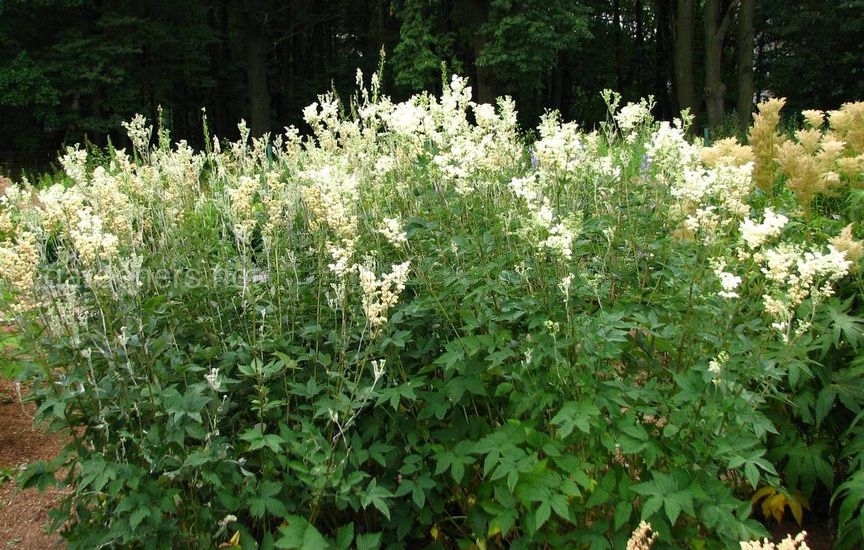 In order for the shrub to have a neat appearance all the time, do not forget to cut off the flower stalks that have begun to wither in a timely manner. To do this, completely cut off the shoot that has faded, or pinch off the withered inflorescence with your hands.
In order for the shrub to have a neat appearance all the time, do not forget to cut off the flower stalks that have begun to wither in a timely manner. To do this, completely cut off the shoot that has faded, or pinch off the withered inflorescence with your hands.
Wintering
Meadowsweet has a fairly high resistance to frost. Shortly before the first frost, shorten all the stems of the bush to 50–100 mm. It is not necessary to cover it for the winter. However, if severe frosts are not uncommon in your region in winter, then it is recommended to cover the area after pruning with a layer of mulch about 10 centimeters thick, for this you can use compost or peat.
Medicinal properties
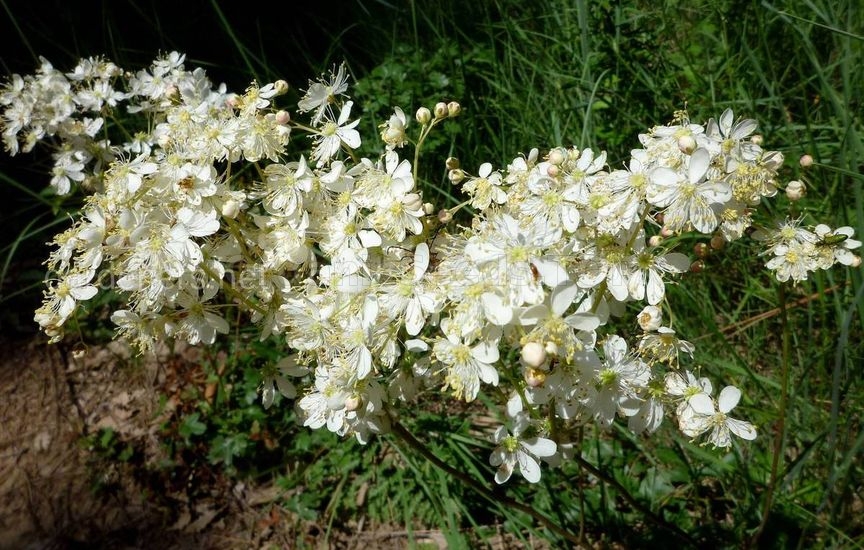 In both official and folk medicine, meadowsweet is considered a medicinal plant that has antimicrobial and anti-inflammatory effects. In the people it is considered "a cure for forty diseases." This plant also has a pronounced antitumor effect, as well as the ability to strengthen the immune system. In folk medicine, meadowsweet is often used to treat flu and colds.
Also, this shrub is used to regulate acidity, for this an infusion is prepared from the flowers, which helps to get rid of heartburn. And this infusion prevents the formation of blood clots in the blood vessels.
In both official and folk medicine, meadowsweet is considered a medicinal plant that has antimicrobial and anti-inflammatory effects. In the people it is considered "a cure for forty diseases." This plant also has a pronounced antitumor effect, as well as the ability to strengthen the immune system. In folk medicine, meadowsweet is often used to treat flu and colds.
Also, this shrub is used to regulate acidity, for this an infusion is prepared from the flowers, which helps to get rid of heartburn. And this infusion prevents the formation of blood clots in the blood vessels.
You may need:
|








